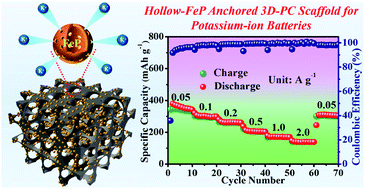Synchronous nesting of hollow FeP nanospheres into a three-dimensional porous carbon scaffold via a salt-template method for performance-enhanced potassium-ion storage†
Abstract
Potassium-ion batteries (KIBs) are highly considered as the leading choice for grid-level energy storage systems owing to their low price and vast potassium reserves. In pursuit of better battery performance, metal phosphides are explored as promising high capacity anode materials for KIBs, which are nevertheless still plagued by inferior electronic conductivity and considerable volumetric changes during repeated potassiation/depotassiation cycles. As a qualified case to fully utilize the advantages of metal phosphides while meanwhile conquering their major drawbacks, we present this rationally engineered hollow FeP nanoparticle anchored three-dimensional porous carbon (h-FeP@3D-PC) composite for performance-enhanced KIBs. The rigid honeycomb-like 3D-PC scaffold with a substantially interconnected porous structure not only enables sufficient electrolyte infiltration and accelerated ion/electron transport, but also provides spatial confinements to repress unwanted agglomeration and buffer mechanical strain of hollow FeP nanospheres accompanied by potassiation, thereby shaping a more efficient and robust electrode. Consequently, this meticulously designed h-FeP@3D-PC demonstrates remarkable electroactivity for potassium-ion storage in terms of superior capacity (343.5 mA h g−1 at 50 mA g−1) and a prolonged lifespan with a high value retention of 172 mA h g−1 after 2000 loops at 0.8 A g−1, indicating great promise for actual applications.

- This article is part of the themed collection: Organic Materials for Energy Conversion and Storage


 Please wait while we load your content...
Please wait while we load your content...